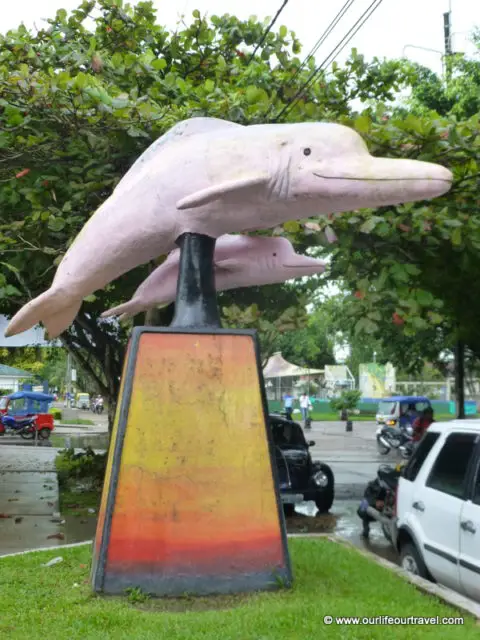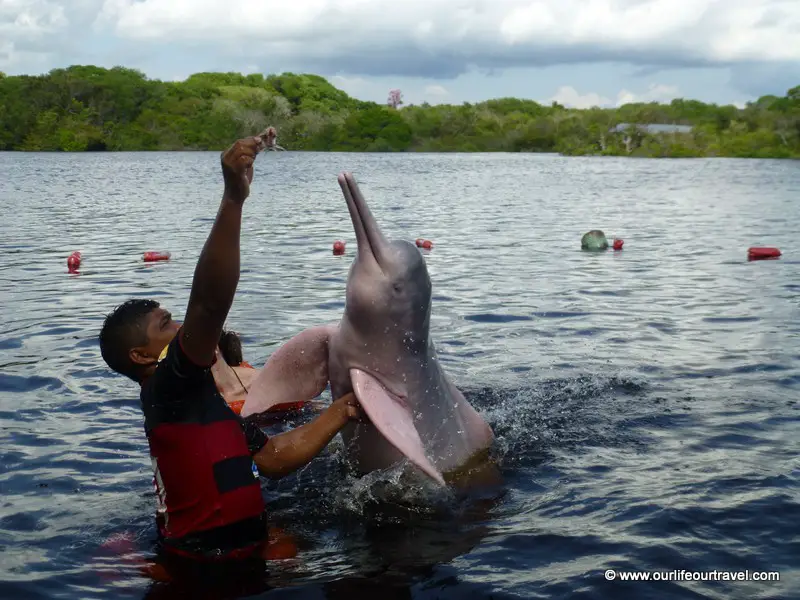Do you know where the pink dolphins live? Why are they so special? We have recently visited the Amazon regions where we spent a week in the rainforest near Manaus. Another week traveling upstream by a freight ferry, and a couple of days in Tabatinga and Leticia near the three-country border. During these times, we have the opportunity to see pink dolphins several times. On one occasion we went swimming with them too (something we wouldn’t have done if we know the program in more detail).
We have read a lot about these freshwater dolphins (they are also called Amazon River dolphins), so we collected the most interesting facts about the pink dolphins for you!
12 Pink Dolphin Facts
The largest sweetwater dolphins
The Amazon River Dolphins are the largest and most widespread freshwater dolphins in the World.
The pink dolphins live in Amazonia
That’s why they are also callee Amazon River dolphins. They live in several countries where the Amazon basin and Orinoco basin spreads. Although the most significant part is in Brazil, it’s not the only country where these pink dolphins live. You can see them in Bolivia, Columbia, Ecuador, Peru, and Venezuela, as well.
They are heavy and long
The adult river dolphins can easily reach 185 kilograms (408 pounds) and 2.5 m (8.2 ft) in length.
The biggest brain of all dolphins
Not only their body is large, their brain as well.
They are pink-grey colored
Although they are called pink river dolphins, their color varies between the shades of pink and grey in reality.
Their head turns upside down
The Sweetwater dolphins can turn their heads 180 degrees. It is a tremendous evolutionary benefit as this way, and they maneuver better in the water.
30-year long lifespan (when they are free)
In nature, they live up to 30 years, but in captivity, unfortunately, their average lifespan doesn’t reach two years. This difference is massive and a strong reason for letting them live in their natural habitat.
Calves are born between July and September
The baby dolphins are born during the dry season of the Amazon rainforest.
They have 130 teeth
The Amazon Dolphins have 130 teeth. They are rather small and sharp.
They are slow swimmers
The Amazon pink dolphins swim slowly. Their average is only 1.5 to 3.2 km/h (0.93 to 1.99 mph), which means you walk faster during a leisure stroll.
They love serenity
The pink dolphins often live alone or in small groups of 2 to 4. Most of the time, we saw them swimming in pairs.
Their skin is valuable leather
Unfortunately, their skin is used for clothing and other leisure purposes. It is a valuable and unique leather.
Where to see pink dolphins?
As we discussed in the quick dolphin’s facts part, they live in numerous countries, but it doesn’t mean you have the same opportunity to observe them in all locations. Let’s see the three countries where you have the most significant chance to see pink dolphins in nature.
Pink dolphins Brazil
Most of the pink river dolphins live in Brazil, but they are in the less inhabited areas. You have the best chance to see them around Manaus or near Tabatinga, close to the Peruvian and Colombian border. Still, you can find them everywhere in the Amazon and Orinoco river basins. We saw them near Manaus several times and from the freight ship while going from Manaus to Tabatinga.
Pink dolphins Peru
In Peru, The Pink dolphins also live in the Amazon River basin. Some of the best places to see them are Iquitos, the Pacaya-Samiria Reserve, and the Upper Amazon River (for example, near Santa Rosa).
Pink dolphins in Colombia
The Colombian Amazon is the area you should head to see the pink dolphins in nature. Leticia is one of the more significant settlements there; they even had a pink river dolphin statue!

These animals are particular unique creatures – similar to everything else that lives in the Amazon region. If you want to visit the area and see them with your own eyes, make sure you do your research before so that you don’t end up on a disappointing swim with pink dolphins tour, as we did. There are millions of amazing adventures that you can have in the rainforest, so be smart and observe these creatures when they are free.
Travel Resources
There is nothing better than a relaxed holiday. To ensure your rest, make sure you reserve and book your accommodation and transportation in advance of your trip.
- Book a small group of private tours with us at amazinglapland.com to make your experience magical in Lapland.
- Don’t forget to insure yourself during your travels: SafetyWing. Check out their policies HERE. It also covers several virus-related expenses.
- Look for the best prices on flight tickets, hotels, and car rentals: Expedia
- Car rental: SIXt
- Accommodation: Booking.com, Agoda or Hostelworld if you travel on a budget. Don’t forget that you can search for Apartments also on Booking.
- Activities: GetYourGuide
- Opinions on hotels and restaurants: TripAdvisor
- Was your flight canceled or delayed? Get up to 600€ back with the help of Compansair!
About the Author

Katalin
Katalin is a Lapland-based outdoor enthusiast who loves hiking, road-tripping, and traveling with her family. She spends her free time far away from civilization in one of the national parks around the world, explores off-the-beaten-path places, or hops on a road trip with her kids in an RV.
Read more about her adventures and the blog.


Why? Why was it a bad idea to swim with them? This made the article seem like click bait
If you click on the linked article, you can see the reasons why we don’t recommend swimming with them. https://ourlifeourtravel.com/swim-pink-dolphins-manaus-brazil/
It supports animal tourism which makes, in the end, the whole dolphin population rely on humans and lose their natural ability to get their own food – among other things.